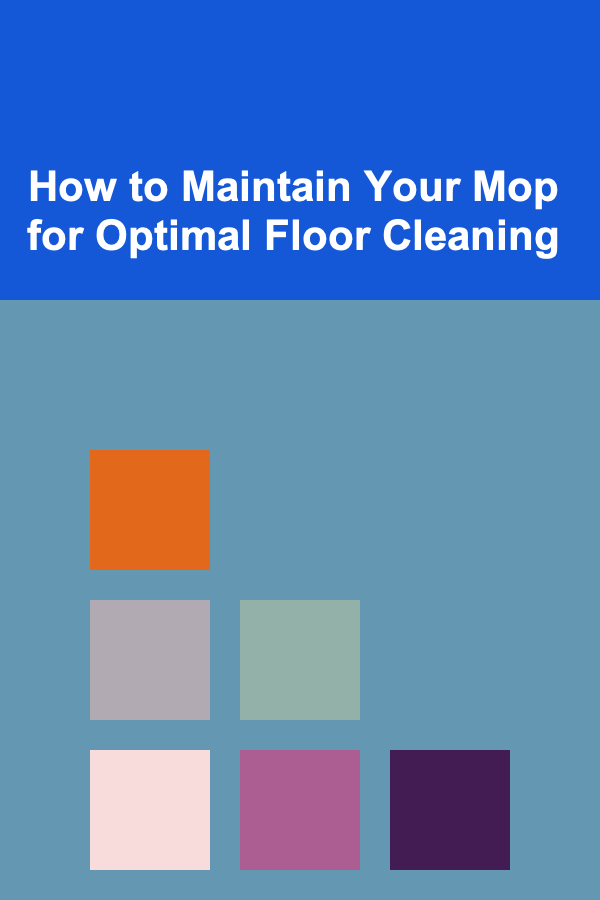
How to Maintain Your Mop for Optimal Floor Cleaning
ebook include PDF & Audio bundle (Micro Guide)
$12.99$5.99
Limited Time Offer! Order within the next:

A clean mop is the cornerstone of a clean floor. Neglecting the upkeep of your mop can lead to a host of problems, ranging from ineffective cleaning to the spread of bacteria and unpleasant odors. This comprehensive guide will delve into the essential practices for maintaining your mop, ensuring it remains an effective and hygienic tool for achieving sparkling clean floors. We'll cover various mop types, cleaning techniques, drying strategies, and preventative measures to prolong the life of your mop and optimize its performance.
Understanding Different Mop Types and Their Specific Needs
Not all mops are created equal. Understanding the type of mop you own is crucial for tailoring your maintenance routine. Here's a breakdown of common mop types and their specific care requirements:
1. String Mops (Cotton or Synthetic)
String mops, particularly cotton mops, are among the most traditional and widely used options. They are absorbent and effective for cleaning large areas. However, their absorbency also makes them susceptible to harboring dirt and bacteria if not properly maintained.
Key Maintenance Considerations:
- Rinsing: Rinse the mop thoroughly after each use. Avoid leaving it soaking in dirty water. Change the water in your bucket frequently during the cleaning process.
- Cleaning: Periodically clean the mop head more thoroughly. This can be done by soaking it in a solution of hot water and detergent, bleach (use sparingly and with caution, especially on colored mops), or a commercial mop cleaner.
- Drying: Proper drying is essential to prevent mildew and bacterial growth. Hang the mop head down in a well-ventilated area to allow it to dry completely. Avoid leaving it clumped together, as this will hinder drying.
- Replacement: Cotton mops, in particular, have a shorter lifespan than other types. Replace the mop head when it becomes excessively soiled, frayed, or develops a persistent odor.
2. Sponge Mops
Sponge mops feature a sponge head attached to a handle. They are known for their ability to absorb spills quickly and are often preferred for cleaning smooth, non-porous surfaces.
Key Maintenance Considerations:
- Rinsing: The sponge head needs frequent rinsing during and after use. Many sponge mops have a built-in wringing mechanism that helps to remove excess water and dirt.
- Cleaning: Regularly clean the sponge head with a disinfectant solution to kill bacteria and prevent odors.
- Replacement: Sponge heads wear out over time and can become brittle or cracked. Replace the sponge head when it shows signs of wear and tear or becomes difficult to clean.
- Drying: Ensure the sponge head is completely dry between uses to prevent mildew. Store the mop in a dry, well-ventilated area with the sponge head extended if possible.
3. Microfiber Mops
Microfiber mops are increasingly popular due to their superior cleaning ability and durability. Microfiber cloths have a unique structure that effectively traps dirt and grime. They come in various forms, including flat mops, dust mops, and spray mops.
Key Maintenance Considerations:
- Washing: Microfiber mop heads are usually machine washable. Wash them separately from other laundry to avoid lint contamination. Avoid using fabric softener, as it can reduce the microfiber's absorbency.
- Drying: You can air dry or tumble dry microfiber mop heads on low heat. Avoid high heat, as it can damage the fibers.
- Rinsing: Rinsing under running water between dips in your cleaning solution prolongs the life of the mop pad.
- Rotation: Consider having multiple microfiber mop pads to rotate during a cleaning session, ensuring that you are always using a clean pad.
4. Steam Mops
Steam mops use hot steam to clean and sanitize floors without the need for harsh chemicals. They are effective for removing dirt, grime, and bacteria from hard surfaces.
Key Maintenance Considerations:
- Water Tank: Regularly empty and clean the water tank to prevent mineral buildup. Use distilled water in the tank to minimize mineral deposits.
- Mop Pads: Steam mops typically use washable microfiber pads. Follow the same washing and drying instructions as for regular microfiber mops.
- Descaling: Periodically descale the steam mop according to the manufacturer's instructions to remove mineral deposits from the heating element.
5. Flat Mops (with disposable pads)
These mops use disposable cleaning pads attached to a flat mop head. They are convenient for quick cleanups, especially on hard floors like tile or laminate.
Key Maintenance Considerations:
- Pad Disposal: Properly dispose of used pads after each use. Check local regulations regarding proper disposal methods.
- Handle Cleaning: Wipe down the mop handle regularly with a damp cloth and disinfectant.
- Head Cleaning: Inspect the mop head attachment mechanism and clean it regularly to remove any debris or buildup.
Essential Cleaning Practices for Your Mop
Proper cleaning after each use is paramount to prevent the accumulation of dirt, bacteria, and odors. Here's a step-by-step guide to cleaning your mop:
1. Immediate Post-Use Rinsing
The first and most crucial step is to rinse your mop thoroughly immediately after each use. This removes loose dirt and debris before they have a chance to dry and become embedded in the mop fibers. Rinse the mop under running water until the water runs clear. For string mops, this may require vigorous squeezing and shaking to dislodge trapped particles.
2. Deep Cleaning (Weekly or Bi-Weekly)
In addition to rinsing after each use, a more thorough cleaning is necessary on a weekly or bi-weekly basis, depending on how frequently you use your mop. This deep cleaning will remove stubborn dirt, kill bacteria, and prevent odors.
Methods for Deep Cleaning:
- Detergent Soak: Fill a bucket or tub with hot water and add a generous amount of laundry detergent or dish soap. Soak the mop head in the solution for at least 30 minutes, agitating it occasionally to loosen dirt. Rinse thoroughly with clean water until no soap residue remains.
- Bleach Solution: For disinfecting and whitening cotton mops, you can use a diluted bleach solution. Add 1/2 cup of bleach to a gallon of water. Soak the mop head in the solution for 15-20 minutes. Caution: Bleach can damage some mop materials and discolor colored mops. Use with caution and always test on an inconspicuous area first. Avoid using bleach on microfiber. Rinse thoroughly and ensure all bleach residue is removed.
- Vinegar Solution: White vinegar is a natural disinfectant and deodorizer. Mix equal parts white vinegar and hot water. Soak the mop head in the solution for 30 minutes. Rinse thoroughly.
- Commercial Mop Cleaner: Consider using a commercial mop cleaner specifically designed for your mop type. Follow the manufacturer's instructions for dilution and application.
- Machine Washing (for Microfiber): As previously mentioned, microfiber mop heads can be machine washed. Use a mild detergent and avoid fabric softener.
3. Cleaning the Mop Bucket
Don't forget to clean the mop bucket! The bucket can harbor bacteria and grime, which can contaminate your mop and spread dirt back onto your floors. After each cleaning session, empty the bucket and rinse it thoroughly with hot water and soap. Disinfect the bucket with a bleach solution (1/4 cup bleach per gallon of water) and allow it to air dry completely before storing it.
Proper Drying Techniques to Prevent Mildew and Odor
Drying your mop completely between uses is crucial to prevent the growth of mildew and bacteria, which can lead to unpleasant odors and compromise the mop's effectiveness. Here's how to ensure your mop dries properly:
1. Wringing Out Excess Water
Before drying, wring out as much excess water as possible from the mop head. Sponge mops typically have a built-in wringing mechanism. For string mops, you can twist and squeeze the mop head to remove water. Microfiber mops can be wrung out by hand or in a washing machine on a spin cycle.
2. Hanging the Mop Head Down
The best way to dry a mop is to hang it head down in a well-ventilated area. This allows air to circulate around the mop fibers, promoting faster and more complete drying. Many mops have a loop or hole in the handle for easy hanging. If your mop doesn't have a hanging loop, you can use a mop and broom holder or a simple hook.
3. Adequate Ventilation
Ensure the drying area is well-ventilated to facilitate evaporation. Avoid drying the mop in a damp or enclosed space, such as a closet or cupboard. If possible, dry the mop outdoors in direct sunlight, as sunlight has natural disinfecting properties.
4. Avoid Clumping
When drying string mops, avoid leaving the strands clumped together. Separate the strands as much as possible to allow air to circulate between them. You can also use a fan to speed up the drying process.
5. Drying Time
Allow the mop to dry completely before storing it. This may take several hours or even overnight, depending on the humidity and ventilation. A completely dry mop will feel light and free of moisture.
Extending Your Mop's Lifespan: Preventative Measures
In addition to regular cleaning and proper drying, several preventative measures can help extend the lifespan of your mop and maintain its effectiveness:
1. Pre-Sweeping or Vacuuming
Always sweep or vacuum the floor before mopping. This removes loose dirt, dust, and debris that can clog the mop head and reduce its cleaning ability. Pre-cleaning also prevents you from simply pushing dirt around the floor with your mop.
2. Using the Right Cleaning Solution
Choose a cleaning solution appropriate for your floor type and the type of dirt you are trying to remove. Avoid using harsh chemicals or abrasive cleaners that can damage the mop fibers or the floor surface. Always follow the manufacturer's instructions for dilution and application.
3. Proper Mop Technique
Use proper mopping technique to avoid overworking the mop head. Apply gentle pressure and avoid scrubbing too vigorously. Overlap your strokes to ensure complete coverage. Change the water in your bucket frequently to prevent spreading dirty water back onto the floor.
4. Avoiding Abrasive Surfaces
Avoid using your mop on abrasive surfaces, such as rough concrete or heavily textured floors. These surfaces can quickly wear down the mop fibers and reduce its cleaning effectiveness.
5. Storage Considerations
Store your mop in a clean, dry place when not in use. Avoid storing it in a damp or humid environment, as this can promote mildew growth. Hang the mop head down or store it in a way that allows air to circulate around it.
6. Regular Inspections
Regularly inspect your mop for signs of wear and tear, such as frayed fibers, loose stitching, or a damaged sponge head. Replace the mop head or the entire mop when it becomes worn out or ineffective.
Dealing with Stubborn Stains and Odors
Even with proper maintenance, mops can sometimes develop stubborn stains or unpleasant odors. Here are some tips for dealing with these issues:
1. Stain Removal
For stubborn stains, try soaking the mop head in a solution of hydrogen peroxide or baking soda and water. You can also use a stain remover specifically designed for fabrics. Rinse thoroughly after soaking.
2. Odor Elimination
To eliminate odors, try soaking the mop head in a solution of white vinegar and water or lemon juice and water. You can also sprinkle baking soda on the mop head and let it sit for a few hours before rinsing. Ensure the mop is completely dry afterwards.
3. Tea Tree Oil
Adding a few drops of tea tree oil to your cleaning solution can help to disinfect the mop and eliminate odors. Tea tree oil has natural antibacterial and antifungal properties.
4. Sunlight
As mentioned before, drying your mop in direct sunlight can help to kill bacteria and eliminate odors. The sun's UV rays have natural disinfecting properties.
When to Replace Your Mop
Even with the best care, mops eventually wear out and need to be replaced. Here are some signs that it's time to replace your mop:
- Excessive wear and tear: If the mop head is frayed, torn, or excessively worn, it's time to replace it.
- Persistent odors: If the mop head has a persistent odor that you can't eliminate, even after cleaning, it's time to replace it.
- Ineffective cleaning: If the mop is no longer effectively cleaning your floors, it's time to replace it.
- Damage to the handle or other components: If the handle is broken or other components are damaged, it may be more cost-effective to replace the entire mop.
By following these comprehensive maintenance tips, you can keep your mop in top condition, ensuring that it effectively cleans your floors and contributes to a healthy and hygienic home environment. Remember that a clean mop is a happy mop, and a happy mop leads to sparkling clean floors!

How to Add Decorative Lighting to Your Home Without Breaking the Bank
Read More
How to Invest in Commodities for Portfolio Diversification
Read More
How to Stage a Home With an Open Floor Plan for Flow and Function
Read More
How to Take Care of Your Home's Insulation for Energy Efficiency
Read More
How to Use Your Typing Skills for Content Writing and Blogging
Read More
How to Master the Perfect Winged Eyeliner
Read MoreOther Products

How to Add Decorative Lighting to Your Home Without Breaking the Bank
Read More
How to Invest in Commodities for Portfolio Diversification
Read More
How to Stage a Home With an Open Floor Plan for Flow and Function
Read More
How to Take Care of Your Home's Insulation for Energy Efficiency
Read More
How to Use Your Typing Skills for Content Writing and Blogging
Read More